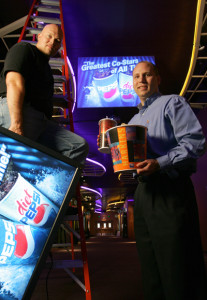[one_third] [/one_third]
[one_third]
[callout title=”The Power of Digital Signage” btn_title=”back” btn_url=”https://auduntaraldsen.me/#background”]
A movie theater increases concession sales by 30 percent.
Now playing at a theater near you:
Quickly, now: Milk Duds or licorice? The bucket of popcorn or the tub? Next to choosing the film itself, this can be the biggest decision a patron faces at the local Cineplex. Theater owners nationwide are increasingly turning to digital signage networks to help customers choose their snacks – and in some cases the theaters are seeing a distinct boost in concession sales as a result.
Eric McCarthy, manager of business development at the 31-location Harkins Theatres chain based in Arizona, notes that some 17-million people pass through the chain’s theaters in a typical year, a larger advertising audience than virtually any other event or medium can provide.
During the past years, Harkins has rolled out a networked digital signage system called HDN, the Harkins Digital Network. The HDN combines 40-inch NEC LCD displays, NEC 60-inch plasmas, and suspended 100-inch HoloGlass screens provided by Harkins’ systems integrator, Tempe, AZ-based NORVISION. The HoloGlass screens are served by dual-lamp, liquid-cooled Panasonic projectors.
Audi Taraldsen, President of NORVISION, notes that the “edgeless” design of the suspended screens created the impression that images are literally floating in space – as if unconnected to any support or structure at all. This effect makes the HoloGlass very effective when it comes to showing ads and movie previews.
“We started knocking on Harkins’ door and suggested to them what could be done,” Taraldsen says.
And after an extended courtship, NORVISION finally got an initial setup assignment in 2004 that has expanded several times since.
One-third of the promotional content is taken by Coca Cola, with the rest split among other vendors who pay $7,500 per quarter to run their ads, McCarthy explains.
How’s it been going so far? “We don’t have any vendor who is disappointed at all,” says McCarthy, citing several examples.
Marshmallow Peeps candies are a seasonal offering the chain puts out around Easter. Last year, without the digital signage, Harkins concessions sold 5,000 units of Peeps; this year, with the signs, the number hit 15,000.
“We used to do promotion campaigns based entirely on static imaging,” McCarthy explains. “We got rid of all that, and now do only the digital signage. When it’s not running, we drop dead.”
NORVISION provides management and support for the HDN and services locations in Arizona, California, Denver, Oklahoma and Texas. Content is managed is Scottsdale, Arizona and distributed daily to all locations.
Concession sales are 30 to 35 percent better when the digital signs are in action, he adds. Comparing locations with digital signage to similar ones without, the participating sites average 30 percent better sales.
Considering maintenance, hardware and software, the network costs about $40,000 annually to operate, McCarthy says. Vendors who previously provided counter cards, posters, and other static displays have found that printing costs alone used to equal or exceed what it now costs to advertise onscreen.
The digital system offers some side benefits, as well. Service is faster because people arrive at the counter knowing what they want. Plus, their time in line is more entertaining, McCarthy says.
[/callout]
[/one_third]
[one_third_last]

[/one_third_last]
